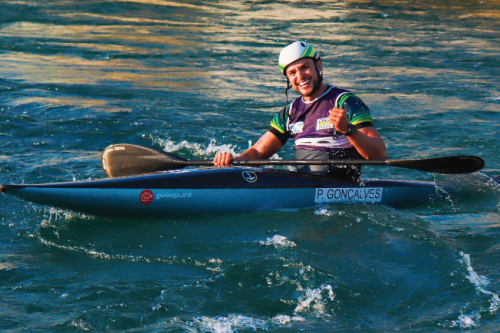
Sea kayaking - the ingredients for skilful performance
I am sure we have all enjoyed a day out when we are being challenged by the environment or conditions and having our paddling skills stretched. It is times like these when our skills are most likely to develop, but it is also times like these when we end up asking ourselves – how can I get better! No doubt there will be someone else we are paddling with making something we find difficult look effortless; or you just never quite manage to catch that wave and are left wondering ‘why’? The environment in which we paddle is very dynamic and changeable, and to paddle in it skilfully requires the perfect balance of ingredients to be applied in harmony with all that is around. In many ways skilful paddling is just like a fine malt whisky!

To understand how we can become more skilful or how another paddler is making something look so effortless, we need to first understand the ingredients of skilful performance. Psychology and physiology are obviously core to this, but to get us going let’s focus on ‘Technical’ and ‘Tactical’ skills:

Technical skills – ‘the core ingredients of performance’
These are in essence the strokes we use to manoeuvre our boat, whether that be forward, backwards, sideways, turning or stabilizing. Without these we are not going anywhere, yet to become more skilful we can make these manoeuvring strokes more effective (getting the most from a stroke) or efficient (getting more for less effort in a stroke). You clearly need to consider which stroke works best for you as a paddler to achieve certain outcomes, however to then maximise effectiveness/efficiency with that stroke the best starting point is to consider the following ‘three B’s’:

Boat – with often over 5 metres of plastic/fibreglass to move, then starting by considering how best to get the boat performing for you is essential. This is considering things like: flat or edged; optimum edge for stroke outcome; stable or unstable; solid edge or wobbly edge; connected & well fitted in boat or unconnected & loose/tight in boat.
Body – our body inevitably is the engine that drives everything, but is it fine-tuned and set up to be able to do this for the stroke being attempted? Have we considered: an active posture that is sat up and ready to go; amount of rotation; flexibility; when and how much to rotate; where and when to put pressure through our connections with the boat (feet, knees, thighs, hips, butt cheeks); where are we looking; are we pre-rotating; do we need to lean forward or back; have we got good upper and lower body separation.
Blade – our body may be the engine but our blade is the propeller and rudder all in one. It should feel like an extension to our bodies that is working in constant harmony with us, for this to happen though we need to check a few things: is it held far enough away from the body to have freedom to move; is it being held in a relaxed way; is it generating good power transfer direct to the body/boat; is it instantly ‘gripping the water’ once placed; is it in depth so we ‘get our monies worth!’; where is it optimum for it to enter/exit the water; how horizontal/vertical does the shaft need to be; how flat (support) or vertical (power) does the blade need to be; how much feather/angle of the blade and when.

Tactical skills – ‘using the ingredients in the environment’
No matter how good your ‘technical’ skills are, if they are not being used in harmony with the environment and the desired outcome then they will not be as effective and/or efficient as they could be. Good tactical awareness and foresight is perhaps the main way the majority of paddlers can become more skilful in all they do; for me this is the ‘silver bullet’ of skilful performance. To help with this we can make use of the TASTE acronym, but being aware that differing environments will require it applied in different ways:
Timing – this is all about considering when you start/finish a given stroke to perhaps get on a wave, cross into a flow of water or turn in the wind. It is also about when you do the manoeuvre in relation to the environment; timing to turn on top of a wave or with swell surges when rock hopping.
Angle – getting the optimum angle of approach and positioning is so often critical to a positive outcome. This could be when rock hopping, taking a wide angle in to get a tight angle out; or crossing into a flow when too wide angle is unstable or too tight the turn is slow; or catching a wave and angling straight down it means you outrun it versus at an angle means you surf along it.

Speed – so often going too fast means we are out of control, but too slow and everything just stalls and is unstable. Momentum is everything, but when and how much is critical! Optimum speed is required to catch a wave and is often pretty fast; to cross into flow the speed is critical for stability when getting across eddylines; and when rock hopping you need just the right speed to get through surging gaps in control.
Trim – this is all about how the weight is distributed in the boat and where/how much the keel/hull of the boat is digging into the water most. At its simplest it is how we have packed the boat, but by altering how we move our upper body fore and aft can also have huge effect. Every boat and every body is different, so this takes some experimenting with. In the wind it is critical for aiding up/down wind turns or when surfing a wave fore/aft body trim can act as an accelerator/decelerator.
Edge – when interacting with the environment then considering when an edge is needed and how much is key. To turn on the wave face then just the right amount of edge will make all the difference, the same when crossing into a flow of water or when turning of a swell surge when rock hopping.

Are you paddling like a fine malt whisky?
You are now armed with some ingredients to skilfully perform in any environment; however, the reality is that on a sea that constantly changes it is not that simple! Take time to consider which balance of ingredients you need for what environment, and then how you may need to adapt the ingredients as things change. Get that all sorted and you will be skilfully paddling with the perfect balance of ingredients, just like that fine Scottish malt whisky!










